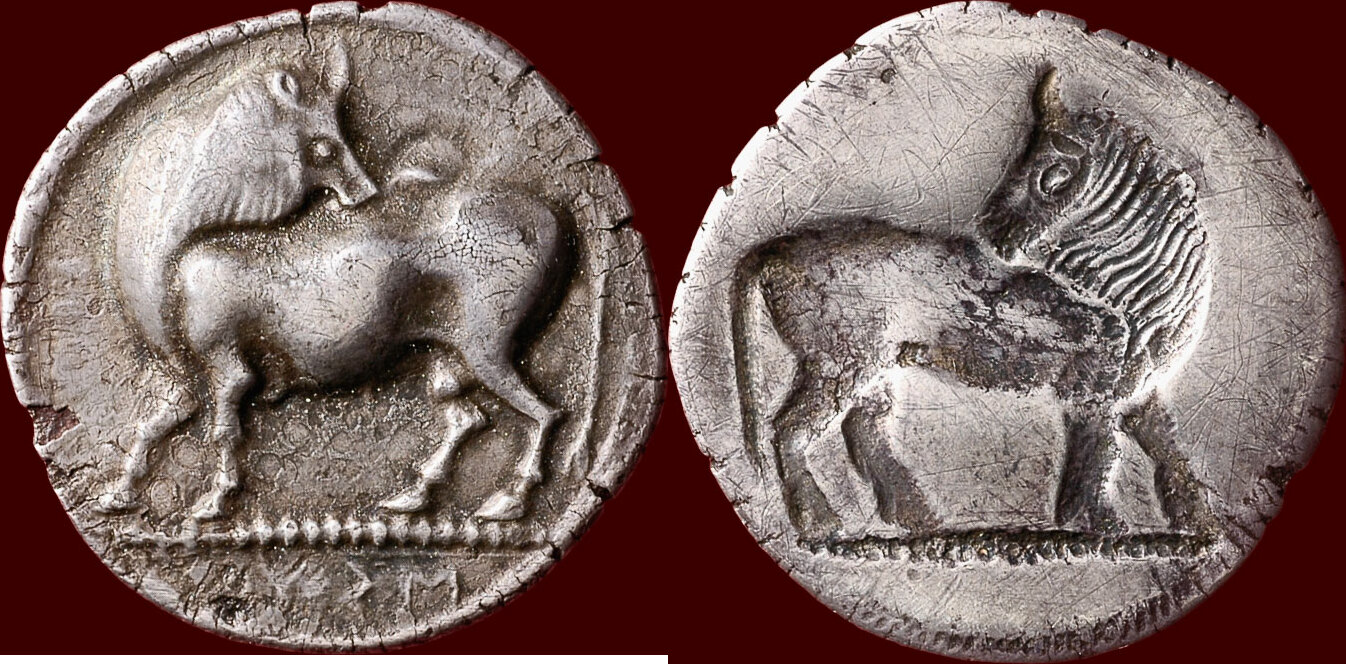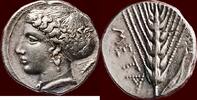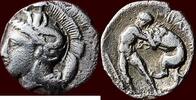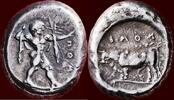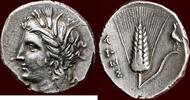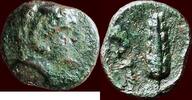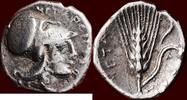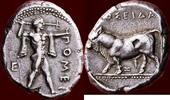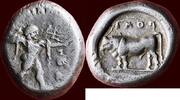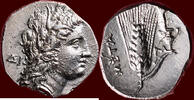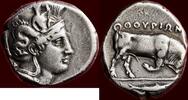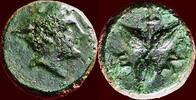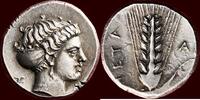MA-ID: 7013602010
Customer feedback Henzen
Schnelle Lieferung. Super Ware. Vielen Dank!
O.K.
perfekt !!!
Great coin, quick delivery, thanks!
540-510 BC v. Chr. LUCANIA - SIRINOS - AR Nomos or tridrachm, circa 540-510 BC (ex. Rosen Collection) alliance stater of Sirinos & Pyxis), lot 503 in
Munthandel G.Henzen 

10
On MA-Shops since 10 years
7244 ratings,
100 % Positive (last 24 months)
Worldwide shipping
39,012.76 £45000,00 EUR
Import tax may be added
+ 24.27 £ shipping ( to United Kingdom )
Delivery time: 5 - 8 days
+ 24.27 £ shipping ( to United Kingdom )
| Customer Support +49 (0)2871 2180 383 |
| Payment methods |
| Wire Transfer |
alliance stater of Sirinos & Pyxis), lot 503 in | Abbreviations
BMC 1-2var. | SNG.ANS.- (cf.816) | SNG.Copenhagen- (cf.1387) | SNG.München- (cf. 1153var. | Jameson Coll.- (cf.344) | Gorini- (cf. 2) | Rosen Collection 14 (this coin) |
27.00 mm
weight 8,10gr. | silver Ø 27mm.
obv. Bull walking left, looking backwards,
ΣIPIN retrograde in exergue (in archaic characters)
rev. Incuse bull standing right, looking backwards. No text.
The unusual fabric of this piece follows a style peculiar to Greek southern Italy in the archaic period: A broad, thin flan, obverse depicted in relief, the reverse repeating the obverse motif but in negative relief, or incuse, and reversed. Creating such coins required a high degree of technical skill and quality control. The reasons for the popularity of this fabric are poorly understood some scholars have postulated a connection to the mathematician-philosopher Pythagoras, who was active in Italy during this period and taught a creed which stressed the duality of mankind′s nature and all existence.
The word "Sirinos" was thought at one time to be the adjective relating to Siri, the city on the Ionian coast which was well known for its wealth and which was destroyed by the coalition of Sybaris, Metapontum and Croton in the years 570-560. Paola Zancani Montuoro, however, believes that the word in question is a noun and, for a variety of reasons, argues that a city called "Sirinos" (of the Sirini, a population from Lucania of which Pliny the Elder speaks in his "Naturalis historia" III 15, 97) existed and was situated about 30 km from Policastro. It has probably been identified in the ruins of a vast inhabited area on a rocky peak which stretches along the valley of Lauria near Rivello and which is still known as "The City". The bull looking backwards, and the coin′s weight, are typical of Sybaritic coins.
This coin related to those issued jointly by Siris & Pyxus, which carry the Pyxus ethnic on the reverse. While the latter are not common, coins with the name of Sirinos alone are extremely rare. Two examples appeared in the Sambon-Canessa sale, 7 may 1903 (Maddalena), 400, 401. One examiner of this specimen believes there may be traces of the Pyxus legend on the reverse. Examination under the microscope at the ANS, however has not revealed traces of an inscription or of tampering with the die. Until recently, the obverse legend was associated with the city of Siris. Now, with the discovery of the site of Sirinos close to Pixys, Sirinos seems the more likely mint. (see Kraay, ACGC.page 166). Coin of great numismatic importance and if the highest rarity. provenance: ex. Rosen collection, which was catalogued by
Nancy M. Waggoner for the American Numismatic Society.
BMC 1-2var. | SNG.ANS.- (cf.816) | SNG.Copenhagen- (cf.1387) |
SNG.München- (cf. 1153var. | Jameson Coll.- (cf.344) | Gorini- (cf. 2) |
Rosen Collection 14 (this coin) | ABM- (cf, 166) | cf. Gulbenkian Coll.83 |
cf. CNG.review winter 2001-2002, no.7 cf. Pozzi 214 | cf. Mangieri D 10
cf. Historia Numorum 1722 | cf. Babelon, traité I, 2085 and pl. LXVII, 3 |
cf. Perret XVI | Sear- (cf.244) cf. NAC Auction 59 (the more common
alliance stater of Sirinos & Pyxis), lot 503 in xf : CHF 110.000 +17,5%)
Light scratches on the revese. Attractive tone.
vf
obv. Bull walking left, looking backwards,
ΣIPIN retrograde in exergue (in archaic characters)
rev. Incuse bull standing right, looking backwards. No text.
The unusual fabric of this piece follows a style peculiar to Greek southern Italy in the archaic period: A broad, thin flan, obverse depicted in relief, the reverse repeating the obverse motif but in negative relief, or incuse, and reversed. Creating such coins required a high degree of technical skill and quality control. The reasons for the popularity of this fabric are poorly understood some scholars have postulated a connection to the mathematician-philosopher Pythagoras, who was active in Italy during this period and taught a creed which stressed the duality of mankind′s nature and all existence.
The word "Sirinos" was thought at one time to be the adjective relating to Siri, the city on the Ionian coast which was well known for its wealth and which was destroyed by the coalition of Sybaris, Metapontum and Croton in the years 570-560. Paola Zancani Montuoro, however, believes that the word in question is a noun and, for a variety of reasons, argues that a city called "Sirinos" (of the Sirini, a population from Lucania of which Pliny the Elder speaks in his "Naturalis historia" III 15, 97) existed and was situated about 30 km from Policastro. It has probably been identified in the ruins of a vast inhabited area on a rocky peak which stretches along the valley of Lauria near Rivello and which is still known as "The City". The bull looking backwards, and the coin′s weight, are typical of Sybaritic coins.
This coin related to those issued jointly by Siris & Pyxus, which carry the Pyxus ethnic on the reverse. While the latter are not common, coins with the name of Sirinos alone are extremely rare. Two examples appeared in the Sambon-Canessa sale, 7 may 1903 (Maddalena), 400, 401. One examiner of this specimen believes there may be traces of the Pyxus legend on the reverse. Examination under the microscope at the ANS, however has not revealed traces of an inscription or of tampering with the die. Until recently, the obverse legend was associated with the city of Siris. Now, with the discovery of the site of Sirinos close to Pixys, Sirinos seems the more likely mint. (see Kraay, ACGC.page 166). Coin of great numismatic importance and if the highest rarity. provenance: ex. Rosen collection, which was catalogued by
Nancy M. Waggoner for the American Numismatic Society.
BMC 1-2var. | SNG.ANS.- (cf.816) | SNG.Copenhagen- (cf.1387) |
SNG.München- (cf. 1153var. | Jameson Coll.- (cf.344) | Gorini- (cf. 2) |
Rosen Collection 14 (this coin) | ABM- (cf, 166) | cf. Gulbenkian Coll.83 |
cf. CNG.review winter 2001-2002, no.7 cf. Pozzi 214 | cf. Mangieri D 10
cf. Historia Numorum 1722 | cf. Babelon, traité I, 2085 and pl. LXVII, 3 |
cf. Perret XVI | Sear- (cf.244) cf. NAC Auction 59 (the more common
alliance stater of Sirinos & Pyxis), lot 503 in xf : CHF 110.000 +17,5%)
Light scratches on the revese. Attractive tone.
vf
Please respect our order minimum of 20 Euros. For EU only IBAN payment please. Shippings to China are on risk of the buyer and only payment by bankwire or WISE. Shipping will take place within 5 days after receipt of payment. Sendings to Russia,Ukraine and Israel are not possible. Additional administration- and risk costs for PayPal & creditcard payments. No PayPal or creditcardpayments possible for orders over 10.000 euro.
| Shipping fees | ||||
|---|---|---|---|---|
| up to 86.70 £ | 86.70 £ to 433.48 £ | 433.48 £ to 866.95 £ | over 866.95 £ | |
| Argentina | 27.74 £ | 27.74 £ | 34.68 £ | 34.68 £ |
| Australia | 30.34 £ | 30.34 £ | 34.68 £ | 34.68 £ |
| Belgium | 8.24 £ | 9.54 £ | 11.27 £ | 15.61 £ |
| Brazil | 47.68 £ | 47.68 £ | 47.68 £ | 47.68 £ |
| Bulgaria | 12.14 £ | 13.87 £ | 30.34 £ | 39.01 £ |
| Chile | 43.35 £ | 43.35 £ | 43.35 £ | 43.35 £ |
| China | 34.68 £ | 34.68 £ | 43.35 £ | 43.35 £ |
| Denmark | 9.97 £ | 11.27 £ | 13.87 £ | 17.34 £ |
| Germany | 8.24 £ | 9.54 £ | 11.27 £ | 15.61 £ |
| Estonia | 11.27 £ | 12.14 £ | 13.00 £ | 21.67 £ |
| France | 8.24 £ | 9.54 £ | 13.87 £ | 21.67 £ |
| Greece | 13.00 £ | 21.67 £ | 26.01 £ | 30.34 £ |
| United Kingdom | 21.67 £ | 21.67 £ | 22.54 £ | 24.27 £ |
| Hong Kong | 34.68 £ | 34.68 £ | 43.35 £ | 43.35 £ |
| India | 30.34 £ | 30.34 £ | 34.68 £ | 43.35 £ |
| Indonesia | 30.34 £ | 30.34 £ | 34.68 £ | 34.68 £ |
| Israel | 173.39 £ | 173.39 £ | 173.39 £ | 173.39 £ |
| Japan | 34.68 £ | 34.68 £ | 34.68 £ | 34.68 £ |
| Cambodia | 56.35 £ | 56.35 £ | 56.35 £ | 56.35 £ |
| Canada | 26.01 £ | 26.01 £ | 30.34 £ | 30.34 £ |
| Liechtenstein | 17.34 £ | 17.34 £ | 21.67 £ | 21.67 £ |
| Luxembourg | 9.54 £ | 11.27 £ | 13.87 £ | 21.67 £ |
| Malaysia | 30.34 £ | 30.34 £ | 34.68 £ | 39.01 £ |
| Netherlands | 7.37 £ | 7.37 £ | 9.54 £ | 12.14 £ |
| Norway | 21.67 £ | 21.67 £ | 26.01 £ | 30.34 £ |
| Austria | 9.97 £ | 10.84 £ | 13.00 £ | 21.67 £ |
| Poland | 11.27 £ | 12.14 £ | 14.30 £ | 21.67 £ |
| Portugal | 11.27 £ | 12.14 £ | 15.61 £ | 21.67 £ |
| Romania | 13.87 £ | 15.61 £ | 21.67 £ | 30.34 £ |
| Russian Federation | 173.39 £ | 173.39 £ | 173.39 £ | 173.39 £ |
| Switzerland | 26.01 £ | 26.01 £ | 34.68 £ | 34.68 £ |
| Serbia | 21.67 £ | 21.67 £ | 26.01 £ | 30.34 £ |
| Singapore | 30.34 £ | 30.34 £ | 30.34 £ | 34.68 £ |
| Slovakia | 11.27 £ | 13.00 £ | 17.34 £ | 21.67 £ |
| Spain | 9.97 £ | 11.70 £ | 14.30 £ | 21.67 £ |
| Sri Lanka | 30.34 £ | 30.34 £ | 34.68 £ | 39.01 £ |
| Czech Republic | 10.40 £ | 12.14 £ | 15.61 £ | 21.67 £ |
| Ukraine | 173.39 £ | 173.39 £ | 173.39 £ | 173.39 £ |
| Hungary | 12.14 £ | 13.87 £ | 21.67 £ | 26.01 £ |
| United States | 27.74 £ | 27.74 £ | 30.34 £ | 34.68 £ |
| European Union | 13.00 £ | 14.74 £ | 21.67 £ | 26.01 £ |
| World | 34.68 £ | 34.68 £ | 43.35 £ | 43.35 £ |
Information
Online orders are welcome as always and will be shipped directly.
|
Seller Home | 0Shopping cart | Terms of sale | Contact | MA Terms of sale | Privacy policy | Warranty | MA-Shops New Items Copyright ® 2001-2025, MA-SHOPS Coins All Rights Reserved. Designated trademarks and brands are the property of their respective owners. |
 Buy coins with warranty
Buy coins with warranty



